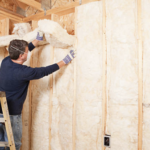Weather can wreak havoc on homes, causing damage that often comes with hefty repair costs. According to recent studies, weather-related damage costs U.S. homeowners billions of dollars annually. From torrential rains to snowstorms, extreme conditions can leave homes vulnerable. Many homeowners don’t realize the extent of these risks until it’s too late.
Weatherproofing your home isn’t just about safety—it’s about making your living space more comfortable and energy-efficient throughout the year. By investing in the right upgrades, you can reduce energy costs, avoid expensive repairs, and ensure your home withstands whatever Mother Nature throws its way. This article explores some practical upgrades to help you protect your home during every season.
Insulate Your Home to Stay Comfortable Year-Round
Insulation plays a crucial role in maintaining indoor temperatures. Without proper insulation, your home is more susceptible to heat loss in the winter and heat gain in the summer. This results in higher energy bills as your HVAC system works harder to regulate the temperature.
Focus on key areas like your attic, walls, and basement, as these are the most common places for energy loss.
Modern insulation materials such as spray foam or rigid foam boards provide excellent thermal resistance. They help in weatherproofing your home and making it cozy during winter and cool during summer, reducing energy waste. If you already have insulation but still notice drafts, consider sealing gaps or adding additional layers. This relatively simple upgrade can lead to significant savings over time.
Upgrade Your Roof for Superior Weather Protection
Your roof is one of the most important shields against weather elements. If it’s old or damaged, it could lead to leaks, structural problems, or even collapse during heavy snow or storms. Taking on a roof installation project is a smart decision.
Consider materials like metal, which is highly resistant to harsh weather, or asphalt shingles, which offer a cost-effective balance of durability and aesthetic appeal. Beyond materials, make sure to address structural integrity by having your roof inspected regularly. A strong roof not only protects your home but also improves its energy efficiency by preventing air leaks.
Install Storm-Resistant Windows and Doors
Windows and doors are common weak points in a home’s defense against extreme weather. Upgrading to storm-resistant models can significantly reduce the impact of strong winds, heavy rains, or freezing temperatures.
Modern storm windows and doors come with reinforced glass and sturdy frames that withstand harsh conditions. Additionally, they improve insulation, keeping your home warm in winter and cool in summer. Some options also include UV-resistant coatings, which protect your interiors from sun damage and reduce glare. These upgrades provide both protection and long-term energy savings, making them a worthwhile addition to any home.
Waterproof Your Basement to Prevent Flooding
Basements are particularly vulnerable to water intrusion, especially during heavy rains or rapid snowmelt. Even minor leaks can lead to significant issues like mold growth, structural damage, and ruined belongings. Waterproofing your basement is an essential step in weatherproofing your home.
Start by sealing cracks in the walls and floor using specialized sealants. Adding a sump pump can help keep water from pooling during storms. Installing a vapor barrier is another effective solution to reduce moisture levels and prevent long-term damage. These measures not only protect your basement but also safeguard your foundation, ensuring your home remains secure and dry.
Invest in an Efficient Heating and Cooling System
Your heating, ventilation, and air conditioning (HVAC) system is key to maintaining comfort through seasonal changes. An outdated or poorly maintained system can struggle to keep up, leading to higher energy costs and less comfort.
Modern HVAC systems are more energy-efficient and capable of handling extreme temperatures. Regular maintenance, such as cleaning filters and checking for leaks, ensures your system runs smoothly. If your current system is outdated, consider replacing it with one that suits your home’s size and climate needs. This upgrade not only improves comfort but also lowers energy costs in the long run.
Protect Your Home’s Walls with Durable Exterior Coatings
Your home’s exterior walls take a constant beating from harsh weather, including rain, snow, and intense sunlight. Over time, this exposure can cause cracking, fading, and moisture damage. Applying durable weather-resistant coatings to your walls is a practical way to extend their lifespan and protect your home.
Exterior coatings are available in a variety of options, including elastomeric paint, which provides a flexible layer that seals cracks and prevents water infiltration. These coatings not only guard against weather but also resist dirt and mildew, keeping your home looking fresh and well-maintained. By investing in this upgrade, you not only protect your walls but also improve your home’s curb appeal.
Keep Your Gutters Flowing with Protective Guards
Gutters are an essential part of your home’s drainage system, guiding water away from the roof and foundation. However, clogged gutters can cause water to overflow, leading to leaks, rotting wood, and foundation issues. Installing gutter guards helps ensure that water flows freely and reduces the frequency of cleaning.
Gutter guards prevent leaves, twigs, and other debris from accumulating, allowing rainwater to drain efficiently. They also reduce the risk of ice dams forming in winter, which can damage shingles and fascia. With this simple addition, you can avoid costly repairs and protect your home from water-related problems.
Smart Home Technology for Weather Monitoring and Control
Weatherproofing your home isn’t just about physical upgrades—it’s also about staying prepared. Smart home technology allows you to monitor weather conditions and adjust your home’s systems accordingly.
Devices like smart thermostats help optimize heating and cooling based on outdoor temperatures, saving energy and improving comfort. Weather sensors can alert you to incoming storms, while automated shutters protect windows during high winds. These technologies provide convenience and peace of mind, ensuring your home is ready for whatever the forecast brings.
Inspect and Reinforce Your Home’s Foundation
The foundation is the backbone of your home, and weather-related issues like water infiltration and freezing soil can weaken it over time. Regular inspections and reinforcements are essential to maintain structural integrity and prevent costly damage.
Look for cracks or signs of moisture around your foundation and address them promptly using materials like hydraulic cement or epoxy. For more severe issues, consider professional solutions such as underpinning or installing drainage systems. Taking these steps ensures that your home remains sturdy and safe, no matter the season.
Secure Your Future by Weatherproofing Your Home
Weatherproofing your home is an investment that pays off in comfort, safety, and savings. From insulating your home to upgrading your roof and foundation, each improvement plays a vital role in protecting your property from seasonal challenges. These upgrades not only shield your home from weather-related damage but also enhance energy efficiency and overall value.
Taking action now can save you significant expenses and stress in the future. Start with one or two upgrades that address your home’s most vulnerable areas, and gradually build a comprehensive weatherproofing strategy. With the right measures in place, you can enjoy a secure and comfortable home all year round.
Want to unlock greater wellness?
Listen to our friends over at the Wellness + Wisdom Podcast to unlock your best self with Drew Canole of Organifi:








 Spicy Elk Chili
Spicy Elk Chili